#the madrigal motif
Text
mirabels birthday so here’s some headcanons !!!🦋💘
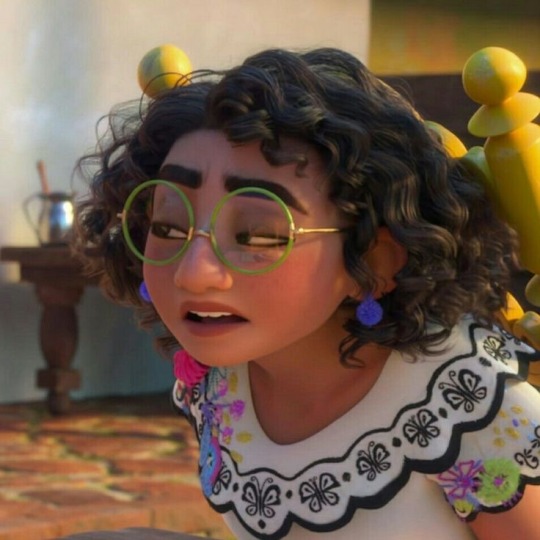
- she zones out a LOT! whatever she’s working on/ thinking about takes priority in her mind so she accidentally gets so invested she could forget someone’s talking to her! (this doesn’t help in school)
- She’s a try hard on everything! probably stems from her giftless status but she gets frustrated if she can’t be up to standards! she ends up exhausting herself or burning out because she overworks herself!
- social butterfly! she’s a people person and loves talking to both the adults and the kids! she loves validation from the adults and being a role model to the kids!
- never stops talking😭 mirabels a professional yapper🙏 DONT ever ask her to explain what she’s working on because she will not shut up ever!!!
- carries around a sketchbook with her and goes to different parts of the encanto for inspiration! she might just doodle a motif or theme but it’s always something! she uses it later in her projects
- stealing @spooky-spextre-arts hc here but I love this one sm!! after Antonio’s plushie he tells the other kids and she makes a load of plushies for everyone!!
- she painted the mural in family madrigal! I think alma is aware mirabels artsy and would have asked her to do it! since it’s special commission that’s why the husbands are absent! mirabel was just so excited to be asked! Also it fits her art style
- she makes clothes! She designs them AND makes them!!
- she has friends! she’s incredibly social and I refuse to believe there’s only 2 teens in the encanto
- she likes cooking with julieta! even if she’s not the best at it she just appreciates the time with her mother!
- she helps Luisa discover her own style! since Luisa’s outfit is for work mirabel makes her other outfits to wear on her days off
- when she gets a crush she’s super annoying about it! Love language is acts of service!
- makes fun of camilo for being cringe (she is also cringe)
- Antonio is her fave cousin (this ones basically canon)
- a home bird!! she can’t ever picture herself leaving the encanto and this causes some friction between her and isa because isa does leave at some point!
- vents to casita about anything and everything (they are best friends)
- still struggles with opening up to people post movie. she’s not user to all the attention on her and gets overwhelmed often (she would never admit it)
- hates her birthdays (this one’s sad ik) but not only is it the anniversary of her ceremony but the day bruno left and in her mind the beginning of the cracks! she’s getting better but it’s still hard! (Her family spoil her for this exact reason)
- when she’s not playing music in the town she often plays with Felix and Dolores!
#encanto#encanto disney#disneys encanto#mirabel madrigal#mirabel encanto#disney’s encanto#encanto headcanons#encanto hcs#mirabel headcanons#mirabel birthday#I probably have more but I’m blanking#happy bday mirabel#my encanto headcanons
84 notes
·
View notes
Text
Okay I HAVE to say it: the slander lin manuel miranda gets is unjust.
Is he annoying? Yes. Is he a GENIUS???? Yes.
His word play alone? Outstanding. His ability to weave in musical motifs? Almost unmatched.
The thing about how he writes for disney is that the songs are deceptively simple. We dont talk about bruno has multiple verses with their own unique patterns over the chord progression. Then, in the last verse, they interlock over each other. It's surprisingly hard to have that NOT song like garbage. (this style is called a Madrigal-- which is the name of the family!!!!)
Disney's new bland music is def an attempt to copy his style without the actual thought he puts into each work.
124 notes
·
View notes
Text

Rosita Barbara Madrigal a.k.a Rose, the lead singer of the Snack Pack made sure her fashion style is classy and stylish and she loved adding symbolism and allegory in the music video. The Snack Pack’s latest music video has a medieval theme, showed her in a sun-like crown with white and gold armor shorts, faux fur collar that mimics the lion’s mane, gold boots, a red cape with white fur, and lots of jewels, cross jewelry, and the angelic motif, which contrasted the leopard outfits of her former friends-turned lifelong enemies’, Velvet and Veneer, and Velvet’s horned tiara.
#dreamworks trolls#trolls band together#trolls 3#trolls oc#queen rose#velvet and veneer#humanization#trolls human au
12 notes
·
View notes
Text
James Elkington and Nathan Salsburg — All Gist (Paradise of Bachelors)
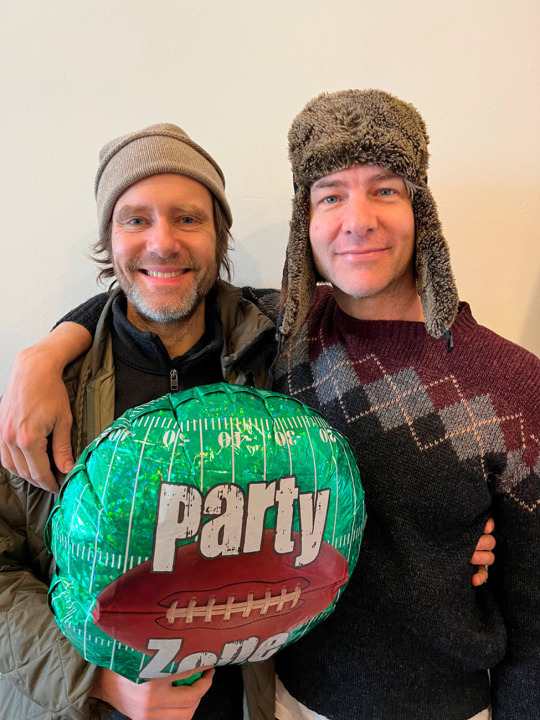
In this third album of guitar duets, James Elkington and Nathan Salsburg perform a complicated sort of dance, their separate instruments executing, light and agile motifs, sometimes in concord, other times slightly out of sync. The melody refracts through their separate interpretations, so that you often feel like you’re hearing it from multiple angles or doubled with an echo. Though some of the songs have a twinge of melancholy, most of them explode with joy. Their two instruments chase each other like dogs at happy play.
Elkington and Salsburg pick up their musical conversation after a long hiatus. Ambsace, their last collaboration, came out in 2015. But like the best reunions, this one is free of awkwardness. They treat each other with warmth and respect throughout. The guitars tangle but never step on one another, each player leaving space for the other.
The pair also makes judicious use of other talent to bolster and deepen their sound. The opener “Death Wishes to Kill” gets a firm grounding from Nick Macri’s acoustic bass; he lends a steadiness to this playful tag in thumps that resonate and mark time without staking too prominent a place for themselves in the sonic mix. But even more striking is the wild skirl of violin that Wanees Zarour adds, wheeling around the guitar line in a throaty emotional timbre. Zarour played on the last Elkington/Salsburg disc. He is a Palestinian-American multi-instrumentalist and academic who teaches at the University of Chicago.
“Nicest Distinction” shows how the foundation that Elkington and Salsburg lay down can be opened up and expanded. It begins in stately ritual, a madrigal with a little blues introduced in the way the phrases end with a vibrating bent notes. It’s just the two of them for a good long while, one strumming splayed chords, the other picking a melodic path in and among the meditations. Yet this long piece kicks into a gallop towards the end, with wild tom-tom fill and woodwinds played by Wednesday Knudsen.
All Gist will likely be lumped into the folk category, being acoustic and not quite modern. Still there is really only one actual folk tune on it, the mortality-shaded frolic of “Rule Bretagne,” based, per the title, on the music of seagoing France. Well, maybe not. “Explanation Point” digs pretty deep into country blues, the notes sliding and tumbling down a sunlight rambling path. Here, as elsewhere, melodic lines zing off each other then carom back for a moment of concord.
But really, the most interesting cuts veer the furthest from conventional folk. “Well, Well Cornelius,” originally written for piano by the British composer Howard Skelton, offers a radiant procession of chords framed by the regular architecture of picking. It is serene and unhurried and really quite beautiful. So, is “Buffalo Stance” a Neneh Cherry song you might remember for its pop-locking hip hop beat and strobe lit video. These artists distill it down to melody—a tune you might not have focused on the original, very different version—and transform the cut into a gentle, bucolic ramble. Ironically, in the video, Neneh introduces her song with an aside of “how melodic” which feels like sarcasm, but these two guitarists heard it there all along. Just lovely.
Jennifer Kelly
#james elkington#nathan salsburg#all gist#paradise of bachelors#jennifer kelly#albumreview#dusted magazine#guitar duets#neneh cherry#howard skelton#finger picking
4 notes
·
View notes
Note
Oh gosh I am looking forward to Constellations!Isa interacting with the Canon Madrigals.
She is here to wreak havoc and drag everyone through their character arcs, kicking and screaming
Have another sneak peek 👀👀
In which Mirabel meets Isa
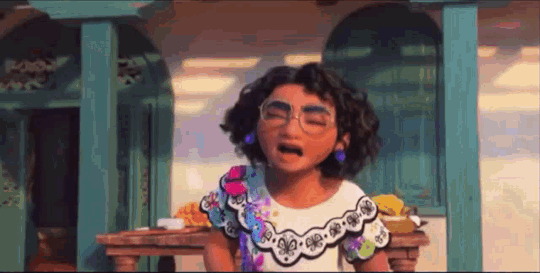
For a moment, Mirabel could only gape in astonishment.
“Isa!?” she gasped. “You- what did you do to your hair?” Just that morning, Isabela’s hair had been perfect and glossy as usual; now it had vivid streaks of blue and green throughout it, and it looked windswept. Not to mention her outfit! High-heeled black boots, a grey, turquoise and blue skirt, and a pale blue blouse…and what was with the hourglass and waves motif?
Mirabel looked at Isabela’s dark, dramatic eyeshadow and bright red lipstick with a confused sort of awe. And, admittedly, a bit of concern. Had Isabela lost it? Or was this some weird prank? No way would Abuela approve of this look.
“What did I do?” Isabela repeated incredulously, hands on her hips. “What did you do to your hair? And…” She looked Mirabel up and down. “Huh. Didn’t think you’d ever wear that skirt, what made you change your mind?”
#answers#asks#writing plans#encanto fanfic#power swap au#role swap au#plant something new#isabela madrigal#madrigal family shenanigans#sneak peek
18 notes
·
View notes
Text
We get a good look at Bruno’s room in canon—but do we really? There’s no furniture anywhere, and the giant hand pointing up the stairs implies that townsfolk came through when seeking prophecies, so how likely is it that Bruno kept his bed directly in their path?
(This is not meant to disparage anyone else’s headcanons. I love the diversity of ideas of everyone trying to figure out where this poor man slept.)
As I mentioned in my post about my design for Pepa’s room, each of the gift bedrooms we see relates to both the owner’s gift and identity, and I’ve additionally been giving each of the triplets sensory themes. Bruno already has associations with sight, sand, and stone, and I took the tower motif and tried to build in ideas about visibility/invisibility and optical illusions, physical manifestations of layers and secrets.
Far above him, a distant focal point, stretched the open sky. Maybe. It didn’t actually match the weather outside, or the weather inside, unless Pepa was in his room. Prophecies made within his tower didn’t darken the skies beyond it. Otherwise, this sky remained clear no matter what happened, yet the constellations matched the ones he and his hermanas looked at while lying on Casita’s roof. Was it a replica of the sky, or a window, somehow peeking beyond the clouds? Whenever he had asked, Casita didn’t know, and that only gave him more questions about how the miracle worked.
Most of the central cavern shone in the midday sun, warm for now, though it would cool quickly when the angle of the light changed and the shadows returned. Rough brown stones broke up sightlines, helping funnel focus to the bottom of the vertiginous loops of stairs.
SU FUTURO ESPERA. The sign pointing up towards his vision cave had reminded Bruno of foam fingers at fútbol games ever since it first rose from the dunes, but since nobody else knew about those he supposed that it looked more ominous. Like the hand of some timeless titan, reaching out of the earth.
However other people felt about it, it did its job. Anyone from town who came to the creepy tower behind the creepy scowling door of the creepy prophet knew exactly where to go, and left the rest of his room alone.
Bruno walked to the left, behind a rock that rose twice as tall as him, and into the hidden tunnel that bored beneath the stairs, invisible from anywhere in the room except directly in front of it. It curved counterclockwise, following the line of the steps, a dark, square edged box of carved rock until it opened into his bedroom.
(As they learn to see, chapter 7)
Bruno’s tower comes in two parts.
First: the main, obvious area, taking up most of the massive space, devoted to both his role in the Encanto/duty as a Madrigal, and to his ominous reputation. Even here, there are hints of his true goofy personality, but they’re easily misinterpreted as threatening, because the way Bruno thinks isn’t the way most people around him think. It opens into a view of something mysterious and untouchable, while also hiding the effects of Bruno’s deliberate prophecies.
Directly across the room, half hidden by the curve of the wall, was the door to his bathroom. A few paces away from the wall, a handful of broad steps, sandstone like the ones to his vision cave, led down to the sunken sleeping area, except for right beside the entryway and by the bathroom door where twin wooden staircases instead led up to his study.
Whatever forces controlled the sand, they continued while his door was dark and Casita couldn’t access the tower, because his room didn’t have anywhere near this much when he had snuck back in to collect some of his belongings.
Now, the sand trailed through the tunnel, ankle deep, and piled against his furniture as if wind had pushed it into drifts. It edged up against the bottom drawers of his dresser and filled the space beneath the bed...
Second: the smaller hidden area with his bedroom, study, and bathroom. His needs and hobbies, things that could both humanize him and make him vulnerable, are visible only to his family members who already know to look, and hidden from everyone who only comes seeking the future. After he entered the walls, sand from the main chamber flooded the room, his reputation in town and the burden of his gift slowly seeping into his family’s private view of him.
More private visions, he stored in boxes in the secret cellar beneath his bedroom, accessible only through a trapdoor hidden beneath his rug and his bed. Some were gruesome, locked away as much so that he didn’t need to look at them as to hide them from prying eyes. But others? ... Spoilers too big to share but too precious to destroy.
But, there is a third area known only to Bruno and Casita: a small cellar below a trapdoor beneath his bed, where he stores the prophecy tablets he doesn’t want anyone to know about. Some are so happy that he doesn’t want to spoil the surprise, but others are physical manifestations of traumas that he doesn’t want to burden his family with, or acknowledge himself. Secrets hidden within secrets and assumptions.
#encanto#encanto meta#bruno madrigal#as they learn to see#please accept my shameless plug for my fic I wrote this all out for#me 🤝 Bruno: making our metaphors as literal as possible
44 notes
·
View notes
Note
6 and 2 for the fic game!
wow am I popular tonight.
6. What part of writing this fic/chapter did you find most challenging?
In Your Honor: Chapter Nine.
I've said it in story comments, but almost every single plot point, AU change, or twist is forecasted before it happens. This chapter has somewhere between 4-7 short and long term story threads but nearly nothing happened.
2.Are there any motifs or themes you focused on in this work? If so, could you explain them?
Ethical Dilemmas and Generational Trauma and no one is exempt.
Morgan is right, Harry is right, hell even Molly is right- in their POVs.
Molly had a storyline following Madrigal Raith, a lust vampire that changed his entire diet out of love. Could there have been a more empathizing way for her to see monsters? It didn't help either of them.
Morgan might as well have lived the Hot Fuzz village of the year experience. Every negative trait he had was rewarded to the point that it almost looked like sabotage.
4 notes
·
View notes
Note
I've a got a prompt for ya: Spider-Man meeting the Madrigal family!!!!
I KNOW YOU'RE GONNA NAIL THIS ONE AS ALWAYS!
Thanks, anon 😭 (omg, the pressure! 😬) I had Tom Holland’s Peter/Spider-Man in mind for this. But man, I need to watch Into the Spider-Verse again.
This turned out longer than three sentences; I don’t know how...
...
As Spider-Man, Peter Parker has seen magic before, and probably knows what to say to the group of people standing before him.
"Hi, I’m Peter. So, you’re, like, superheroes too? Friendly neighborhood... magical family?" His voice trails off a bit as he watches the doors behind the family flap, seemingly of their own volition. “Whoa, cool house.”
The stocky man and the boy who might be about Peter’s age exchange skeptical glances, while the elderly woman steps forward, clearing her throat and staring Peter down. In her eyes, he must appear like a total weirdo, a teenage boy wearing a strange skin-tight outfit with some kind of... spider motif. At least his face is visible.
“Somos los Madrigal. ¿Quién es?”
“Oh, boy,” Peter breathes. He’d made an assumption. “Right. Spanish. Time to make Señora Torres proud.”
He proceeds to search his memory for the word for neighborhood. As he does, the girl with dark curly hair and big green glasses steps forward. She takes the elderly woman’s arm and whispers to her. It’s much too fast for him to follow, but he thinks he hears “Casita.”
The old woman looks vulnerable and austere at the same time as she sighs and inclines her head toward the girl, who waves at Peter to get his attention.
“Este... ¿Habla español?”
“Um,” Peter replies. “Sí? Pero. No hablo español, er, muy bien.” He pauses. Introductions are still in order. “Also, hola, me llamo Peter.”
The girl smiles despite his bumbling. Some of the other members of her family have begun to smile too: the woman in a teal dress who bears a strong resemblance to her, the youngest child with a toucan perched on his shoulder. A couple of them, like the small, tired-looking man in a green poncho, who’s hovering near the boy with the toucan, are regarding him with quite anxious, yet steady, expressions.
“Soy Mirabel,” the girl is saying. A quick pucker of her lips indicates the constellation of people around her. “Mi familia, los Madrigal. Y... el Encanto.” She spreads her arms wide.
“Peter,” Mirabel continues, a bit shyly, with a glance at the elderly woman and the subtly nodding woman in the teal dress. “¿Tiene... hambre?” Above her, the house’s shingles bounce (Ohh, ‘Casita,’ Peter realizes).
“Sure— Uh, bien. I mean, sí. Gracias.” If he ever gets home, at least he’ll be able to assure Aunt May that he was a polite guest.
“Venga, Peter,” the woman in teal says.
With that, he starts to follow this magical family, the Madrigals, into their magical house.
...
I also could’ve written it like, Bruno had a vision of Spider-Man’s arrival 🤔 Ah well. Also: Modern AU? Spider-Man time-travel? Who knows!
Thank you again, @lunaencantada, for checking and answering my Spanish questions! 💚
#encanto#spider-man#mirabel madrigal#bruno madrigal#peter parker#alma madrigal#julieta madrigal#félix madrigal#camilo madrigal#antonio madrigal#marvel#mcu#crossover#my fics#my writing#stuff i've posted#asks#this was just fun to write#sorry if anything's ooc
32 notes
·
View notes
Text
Characters I wanna see in DDLV
if they don't fuck up with this madness of charging the extension chapter the same price of the base game:
- Flora, Fauna and Merryweather (the Sleeping Beauty Fairies)
- TinkerBell and any other fairies from the Neverland
- The Sabderson Sisters (we already got the hairstyle and motifs, I wanna see them on my valley hunting Vanellope down)
- Tiana and Mama Odie (she also counts as a fairy godmother)
- Captain Hook and Peter Pan
- Hans (he and Gaston would be best buddies, thats all the reason why I would like them in my valley)
- Familia Madrigal (I want every single one of them there, even the in-laws)
- Maleficent (she better turn into a dragon too)
- Evil Stepmother (from Cinderella, I'm not gonna explain why, I just want her. In my valley.) And her daughters
4 notes
·
View notes
Text
SDV Character Inspos
SO there was this prompt about character inspos in this SDV server im in and i guess im just in the mood to talk about why i chose the inspo i did LOL LONG POST! will add some other characters later since they're based off more general concepts and not actual characters LOL

Rosario -
1. Zhao Tianyou (y:lad) - literally his voice claim and everything. based alot of him off this guy from his teasing personality and the way he Gets Serious when it comes to people close to him
2. Shun Akiama (Yakuza 4) - Big personality contributor! he's flirty, smart but acts like a dumbass, and like. the perfect amount of sleezy that it comes off as charming LOL
3. Kogitsunemaru (Touken Ranbu) - based the whole white hair, fox motif off this guy. also he's cheeky so what a surprise
4. Geralt of Rivia (Witcher 3) - Less so the character and more so his occupation and world. I yoinked alot of the worldbuilding from the game and yeeted it into my stardew world LOL
5. Majima Goro (Yakuza Kiwami) - its the "he's crazy but one thing is for sure he's loyal as a dog" for me. also the "goating you into fights as a way of flirting" also the whole, living freely and fuck all the bullshit kind of thing. living for yourself and for your best.
6. Luka Redgrave (Bayonetta) - pathetic flirty little shit
7. Dante (DMC: Devil May Cry) - mostly an influence from one of my best friends irl, the badass fuck boy with an attitude i loved, also he's fucking metal i love him
8. Loki Laufeyson (MCU) - a trickster type cocky little shit that gets misunderstood, also enjoying the chaos. and the bisxuality.
9. Vampire Cookie (cookie run) - ...... the hair.
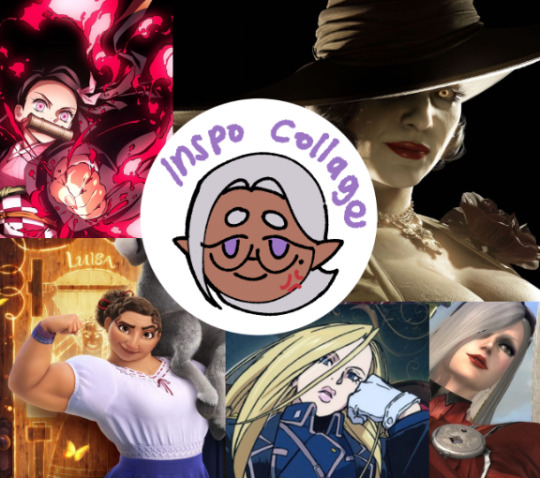
Luz -
Lady Demitrescu (RE: Village) - tall vampire lader that could crush me without a second thought and long extendable nails haw yee
Nezuko Kamado (Demon Slayer) - sister to the MC, unwilling transformation into supernatural creature, struggles to reign in new instincts to prey on humans, cool fire powers that come with cryptid-hood
Olivier Armstrong (Full Metal Alchemist Brotherhood) - shes hot, strong and can kill me
Luisa Madrigal (Enchanto) - shes hot, strong, and can kill me (but she wouldn't) also body type inspo
Jeanne (Bayonetta) - compared to bayonetta (rosario)'s outright flirt-teasing, jeanne (luz) tends to be a little meaner with her goading. also oooo shes hot strong and can kill me (i swear im biromantic)

Rouge -
1. Mirei Park (Yakuza 5) - face claim and also a big personality contributor. manipulative but in a way she wants the best for you, harsh but also for the same reason, intimidating, head strong, reliable, and has gone through way too much shit
2. Kiryu Kazuma (Yakuza) - big family woman like him and is super-unnaturally strong and durable. has his strength and everything. also an orphan that grew up with other orphans, and took care of them.
3. Nishikiyama Akira (Yakuza) - bad bitch honestly LMFAOJFOSDIF no i mean like there was a turning point in Rouge's life where she couldn't go back to what things were, and she fully committed herself to the underworld....
4. Osamu Kashiwagi (Yakuza) - Scars
5. Mine Yoshitaka (Yakuza 4) - yoinked the gayness and last name from this one
11 notes
·
View notes
Note
🐱 🤝🌑 (also hi 🔪 )
Oh heyyyy (is that knife for me? Thanks!) Thanks for the ask, as well!
RAVENOT
🐱 - What are the animals like? Pets? Local fauna?
I'm still worldbuilding, so I don't know too much about distinctive animal life. But I do have Dandelion, who is more of a companion, than a pet. It occurred to me that to do what he does, Ravenot would need a way to carry a variety of supplies. And that's where Dandy comes in. Dandelion is a huge black bull, 6ft tall at the shoulder, best resembling an aurochs. He's sweet as anything, loves treats, and is cleverer than some people (though he understands only the language of the Dead). When the path becomes too treacherous or too narrow, or when greater haste is required, Dandelion can dissipate into smoke, which Ravenot keeps in a five-sided periapt with crisp edges, each one set with a dandelion enlaid in gold.
🤝 - How do the characters meet? (antagonist included!)
Senai meets Ravenot for the first time when she's only a child. She lives in a house by a creek, where Ravenot has come to wait for a shade to rise up, in order to quell it before it does any harm. But it does do harm. She meets Madrigal (who I haven't spoken about) shortly after her first encounter with Ravenot, who comes at the behest of the Order of Balances to help her cope with the aftermath. (The shade does quite the number on little Senai, you see.)
Senai also meets [redacted] in her dreams, because he detected someone who had survived a shadestrike (quite rare) and thought that merited a conversation. [redacted] is a little bastard.
SUGAR O'ER THE DEVIL
🌑 - Is there reoccurring symbolism? Motifs?
I've ripped this whole thing from good old Willy Shakes, and this bad boy? Can fit so much reoccurring symbolism in it. I'm still shovelling it in. The bloody hands, the lambskin, the architecture of Hell. The moving forests, the haunting daggers in the air, and in men's smiles? You can bet I'll be leveraging all of that.
Get to know the WIP asks!
7 notes
·
View notes
Link
0 notes
Text
I see one post about the Madrigal outfit colours and now all I can think about is my adopted tpn kiddos au and where they fit into that.
If anyone was wondering, Don winds up basically a mini-me of Agustín, with the same kind of suit in the same kind of blues, and accents for his sisters and mama. He also has a bunch of green accents to represent the other Grace Field kids that wound up as Madrigals (and a bunny for Conny).
Conny, gets a bright green because she's very happily Bruno's but she's also a little kid and she likes bright colours. She starts tying ribbons around her pigtails though, and they can vary. Usually they're pink or yellow. (She's got shapeshifter solidarity that makes Camilo her favourite cousin, and Antonio is second favourite).
Ray sticks to his Grace Field white shirt for a long time, reluctant to join the family in any meaningful way. When he does start to gain colour, he eventually lands on something of a turquoise. Bruno's son, but closest to his tía Julieta.
Emma is all green all the time, but (much like Mirabel) wants accents of her other family members, because family and love is what she wanted and she's got it, so she has to celebrate it. When she switches to Encanto fashion, the ruffles on her dress are pale, very pale, because as much as she's happy to be there, she's also still fiercely loyal to Ray, and to all the other Grace Field kids that aren't Madrigals.
Then there's Norman, who would match Emma without hesitation just to make her happy, but I can see him actually winding up in a fairly dark brown. No motifs to represent other family members, but brown being the most likely end result of mixing every other colour in the family. It's not clear who exactly he's closest to or more like, but he's undeniably one of them.
0 notes
Text
Vattene pur Crudel - Terza parte
Madrigals were a relatively recent innovation in Renaissance Italy for their setting of lyrics within a polyphonic context. A notable composer of the genre, Claudio Monteverdi, was born in 1567 in the city of Cremona. Part three of “Vattene pur crudel” from his Third Book of Madrigals (1592) is as good an example as any of the enhancement of poetry through his writing within this genre. “Vattene pur crudel” is an excerpt from Torquato Tasso’s epic poem Gerusalemme Liberata (1581) set as lyrics to music in madrigal form. It is a mythicized version of the First Crusade. In the first section of the poem, the Muslim enchantress Armida has been abandoned by the Christian knight Rinaldo whom she had kidnapped and restricted to an island. In the first part of the madrigal, she spits fire and terrifying threats, cursing Rinaldo for his betrayal-by-fleeing. Then, in the second part, she utters one final curse that highlights Rinaldo’s relation to her. At this point, she suffers the expense of the extreme emotions of the moment and faints. The poem concludes in the third part of the madrigal with Armida awakening in silence, lamenting the traitorous actions of Rinaldo. She arrives upon the conclusion that her love of him is tragic and that her inaction as a result is similarly so. With the topic of the writing being so clearly dramatic, Monteverdi was given a lot of room to play. As demonstrated through disruption of the original ottava rima stanza format in favor of dramatization, the usage of the soprano voice to represent Armida as the lyrics switch between her voice and the narrator’s, and the usage of cadences to create sections of the piece with distinct emotional flavors, Monteverdi enhances the emotions espoused in Tasso’s poem providing a more empathizable presentation of “Vattene pur crudel”.
While many more popular translations of Gerusalemme Liberata do not follow the original ottava rima stanza structure in favor of providing a more descriptively accurate version of the poem, the translation of lyrics used for this essay will use a version that does conform to this. In similarity to more popular translations, Monteverdi’s setting of the ottava rima-structured lyrics does not follow 11-syllables-per-line sequentially in favor of creating a dramatic effect in which overlapping lyrics emphasize the tragedy of Armida’s plight. For instance, on the fourth beat of measure 74, the soprano, quinto, alto, and bass sing “...and on this shore though unavenged…” in rhythmic unison. Then, in measure 77, the tenor finishes the line “...still do I sit and weep?” followed by the alto a measure later, the bass six beats later and the soprano and alto in rhythmic unison two measures and two beats later following into a rhythmic unison “sit and weep”. The discoordinated “...still do I sit and weep?” after the previous line shows the tumultuous emotion that underscored its utterance, and then it being repeated in rhythmic unison shows the resignation Armida meets this fate with.
Vattene pur Crudel is of polyphonic texture, where there are multiple independent melodies being played at the same time. And rather than played, the music is in fact sung. This allowed Monteverdi to be able to play with voicing parts of the madrigal between different ranges to create different effects. Monteverdi exploits the range of the soprano voice to represent Armida as the lyrics switch between a narration and Armida’s voice. One instance of can be found at measure 21. At line three of the lyrics, the poem shifts from being the speech of an omniscient narrator to that of Armida herself. Preceding this shift, all of the voices finish the previous line in unison from measure 18 to 20. Starting at measure 21, however, the soprano sets a melody ascending from a G to an A then down two notes, followed by a sequence of quarter notes. This section is accompanied note-by-note the entire next two lines of lyrics. Soon after, the other voices repeat this motif accompanied by the same lyrics note-per-note with one voice entering each measure later. The soprano leading the charge while solidly in this range highlights the line, especially when the other voices re-solidify the pitches and lyrics with each progressive measure. In addition to this instance of voicing, sections spoken by the narrator do not begin with the soprano at all. From the first measure of the piece, the alto begins with the first line of the lyrics on the pitch of A, followed by the soprano a measure later on an E, providing a fifth above the A to fill in the harmony. The entrance of the alto is not highlighted by contrast, nor by a unison in pitch. The harmony lends itself to a sort of a chorus-like voice. As a result, the distinct voicing of the soprano part is representative of Armida.
Cadences that resolve to a I chord in the consistent key of C serve to define transitions between distinct sections of the madrigal, while smaller pauses take place on vi chords. One instance of this can be seen at the very beginning of the piece. As previously mentioned, the poem shifts from being the speech of an omniscient narrator to that of Armida herself in the third line of the lyrics. A cadence on the last line delivered by the narrator, “nothing but empty silence all about her” takes place on a I C major chord, punctuating the landing of this last line with a setting with which Armida’s voice can assume definition of a new theme. This pattern can be similarly observed with vi chords in both the rhythmic unison in soprano, quito, tenor, and bass lead up to measure 40 starting at measure 38 into a diminuendo. The next chord that follows in the quinto, alto, tenor, and bass is a I chord on only G and C. Another example of this can also be seen in measure 60, where the quinto, alto, and tenor have a I cadence on the notes C, A, and E on the beginning of the line “...still do I sit and weep?” in the bass. This lends a particular weight to this moment where the patheticness of sitting and weeping is recalled as an undercurrent of the line “...and do I love him still, and on this shore…” in the soprano. Overall, Monteverdi uses cadences on I and vi chords to his advantage to place emphasis on certain parts of the lyrics.
In the end, Monteverdi enhances the emotions espoused in Tasso’s poem through these means, providing a more empathizable presentation of “Vattene pur crudel”. This is demonstrated through disruption of the original ottava rima stanza format in favor of dramatization, the usage of the soprano voice to represent Armida as the lyrics switch between her voice and the narrator’s, and the usage of cadences to create sections of the piece with distinct emotional flavors. The case of “Vattene pur crudel” is a strong one in the way that Monteverdi shoe-horns a clarity of emotional representation into it. The effectiveness of his use of music towards more deeply emotive ends provides an example for future musicians and composers on how to go beyond simply accompanying lyrics with music to imbue the totality of their music with their own emotive ends.
Bibliography
Claudio Monteverdi. Vattene Pur Crudel, Part Three [Venice], 1592.
Tasso, Torquato. Gerusalemme Liberata. 1581.
0 notes
Photo
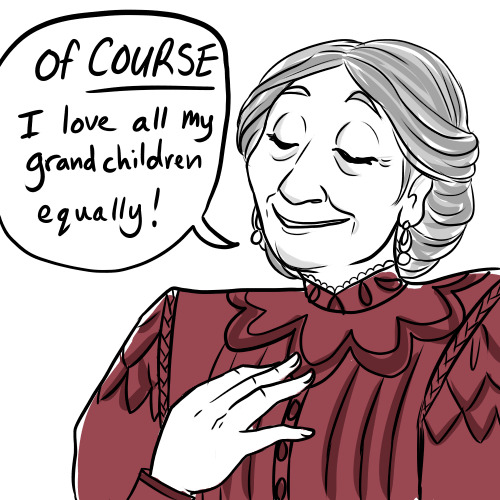
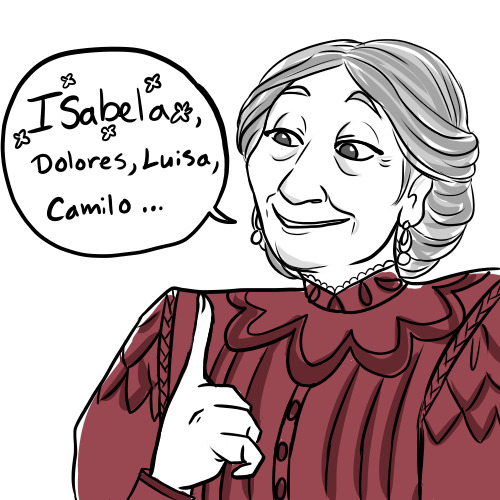
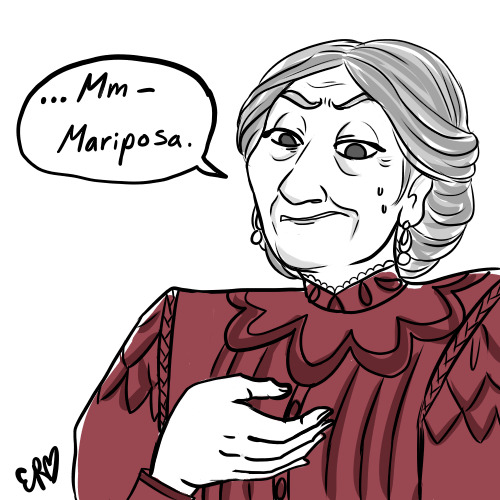
Abuela has no favorites :)
#my art#long post#encanto#abuela madrigal#haha get it cuz of the butterfly motif in the movie???#this movie almost made me cry i deserve to doodle something silly
2K notes
·
View notes
Text
"You're the real gift, kid."
- Bruno to Mirabel in All Of You
Can we talk about how true that is ?
Do you realize Mirabel did everything she said she would do in Waiting On A Miracle...?
❂ "I would move the mountains"
She literally opened a path to the past, breaking the mountain between them and the river where her grandfather was killed
❂ "Make new trees and flowers grow"
She helped Isabela discover the extent of her plant-making powers and find her true self along the way
❂ "Someone please just let me know where do I go"
She found Bruno.
He was just as lost as she was, but he helped her realize the most important thing : she is exactly what the family needs
❂ "I would heal what's broken
Show this family something new"
She stood up for her family when she confronted her grandmother, something none of them dared doing until then.
She listened to them, she repaired their broken bound, she showed them they were more than just their gift...
She gave them support and freedom.
❂ "Bless me now as you blessed us all those years ago
When you gave us a miracle
Am I too late for a miracle?"
You are the miracle, Mirabel.
You were the miracle they needed all along...
#many people told me they did not find the songs in Encanto as memorable as other beloved Disney songs...#they may be right#but there's something I'll keep defending#Lin-Manuel Miranda is a talented lyricist#the lyrics may seem simple at first but they are so much more when you take the time to truly listen to them#there is something he is amazing at : motifs#his songs...they answer each other#themes and words keep coming back and it's super effective#the most important motifs here are ''open your eyes'' and the theme about shining#that's exactly why I got obsessed with Hamilton as a clueless French person who does not care about America's ''founding fathers''#by the way : go watch ''Hamilton and Motifs: Creating Emotional Paradoxes'' on YouTube#this video helped me put words on the emotions his songs make me feel#which is...all of them. I'm overwhelmed. please send help.#Encanto#Encanto spoilers#Mirabel Madrigal#Bruno Madrigal#Madrigal Family#Hamilton#Lin-Manuel Miranda#being very emotional and analytic at the same time is a blessing and a curse...#naelistic train of thought
365 notes
·
View notes